As an Amazon Associate I earn from qualifying purchases.
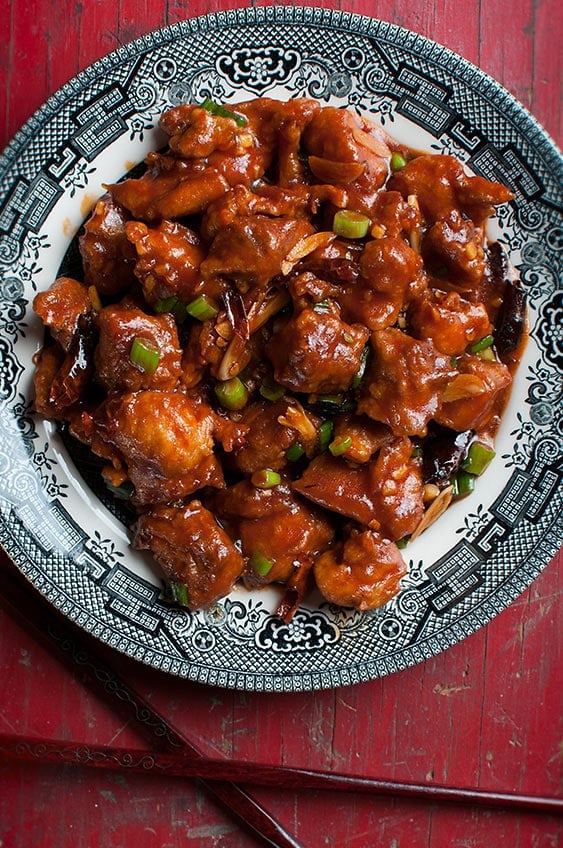
Many of us have eaten The General’s chicken at cheap, steam-table Chinese restaurants: Gloppy, over-breaded and so sweet you fall into diabetic shock afterwards. It’s crap. Especially if you’ve ever eaten General Tso’s chicken in a good Chinese restaurant.
Done correctly, General Tso’s chicken is irresistible: Tender meat with a light, crunchy batter reminiscent of tempura, tossed in a sauce perfectly balanced between sweet and spicy, studded with green onion and Chinese tien tsin chiles. It is the crack cocaine of Chinese food. You want it. No, you must have it. At any cost. I know people who will do shameful things for a plate perfect of General Tso.
This General Tso’s pheasant is that plate, folks. And it has a history.
General Tso was in fact a real general in China. Hunan, to be exact. But the general did not make this dish, nor would he really have recognized it. A Taiwanese refugee from Hunan named Peng Chang-kuei invented this back in the 1950s. Peng’s version was not nearly as sweet or crunchy as what we are all used to; that version has its origin in the early 1970s, when a chef named T.T. Wang, who had eaten Peng’s original in Taiwan, opened a Hunan restaurant in New York City.
By all accounts Peng loathed the American version of his recipe. Too sweet.
And he apparently rolled his eyes at the notion that extraneous vegetables such as water chestnuts or baby corn should appear in the dish, which is supposed to be meaty through and through. Fuchsia Dunlop has more details on the story here, and it is from her excellent Revolutionary Chinese Cookbook: Recipes from Hunan Province that my version originates.
My take on General Tso’s is slightly more powerful and hearty than most “authentic” versions. It is definitely less sweet than the cheapy Chinese style, and definitely spicier. I also make a little more sauce than Dunlop’s rendition because, well, I like the sauce.
And yes, I use pheasant breast instead of chicken. Pheasants happen to be indigenous to Manchuria in Northern China, and this is a wild food blog, after all.
And while I’ve never heard of General Tso’s beef or pork or whatever, I bet you could sub in other meats, too. Rabbit springs to mind. If you do, let me know how it went in the comments section.
Note that while you need a lot of oil to fry the pheasant in, you can reuse it several times. Just let it cool a bit and strain it through a paper towel back into the bottle.
Make this recipe. Then make it again. You will find yourself craving it in an almost unnatural manner. Like I said, it’s basically crack.
General Tso's Pheasant
Ingredients
MARINADE
- 4 tablespoons potato starch or corn starch
- 2 egg yolks
- 1 tablespoon soy sauce
- 3 cups peanut or vegetable oil for frying
SAUCE
- 1/2 cup pheasant or chicken stock
- 1 tablespoon soy sauce
- 1 tablespoon sugar, or more if you want it sweet
- 1 tablespoon Chinese black vinegar or malt vinegar
- 2 tablespoons tomato paste mixed with 2 tablespoons water
- 1 teaspoon potato or corn starch
STIR-FRY
- 1 pound pheasant breast meat, cut into bite-sized pieces
- 3 tablespoons peanut oil, lard or vegetable oil
- 8 dried hot chiles, torn (use less if you don't want it spicy)
- A 2-inch piece of ginger, peeled and minced
- 3 garlic cloves, sliced thin
- 6 green onions, chopped
- 2 teaspoons sesame oil
Instructions
- In a small bowl, mix egg yolks, soy and potato starch together with the pheasant pieces. Set aside at room temperature while you chop everything else. Mix the sauce ingredients together in a small bowl and set aside.
- Pour the peanut oil into a wok or large, heavy pot and heat it to about 350°F. If you don't have a thermometer, you can test by putting a little flour or the end of a wooden chopstick into the oil: If it sizzles immediately, the oil is hot enough. Get a chopstick or something similar ready -- you will need this to quickly separate the pieces of pheasant when they hit the hot oil. Lay out a baking sheet with a paper towel on it for the finished pheasant pieces.
- When the oil is ready, add about 1/3 of the pheasant pieces and immediately use the chopstick to separate them. Fry until they are golden brown, about 2-3 minutes. Remove the pheasant from the hot oil with a slotted spoon and set on the baking sheet. Repeat twice more with the remaining pheasant pieces, frying 1/3 at a time. Doing it this way keeps the oil nice and hot.
- Turn off the heat and let the oil cool a bit. Pour it into a heatproof container (I use a large Pyrex measuring cup) and deal with it later. Wipe out the inside of the wok if using. If you are not using a wok, get out a large saute pan.
- Heat the 3 tablespoons of peanut oil in the wok over high heat for 1 minute. Add the dried chiles and cook until they almost turn black, another minute or two. Add the ginger and stir fry 30 seconds, then add the garlic and stir fry another 30 seconds.
- Add all the pheasant pieces and the green onions. Stir the sauce in the bowl and add that, making sure you get all the potato starch, which will have sunk to the bottom. Stir fry 1 minute. Turn off the heat and mix in the sesame oil. Serve at once with steamed rice.
Notes
Nutrition
Nutrition information is automatically calculated, so should only be used as an approximation.
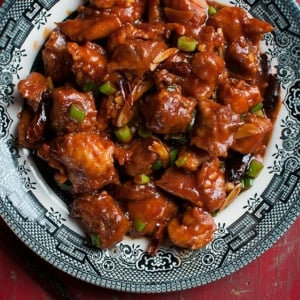
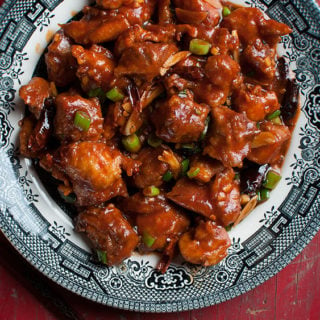
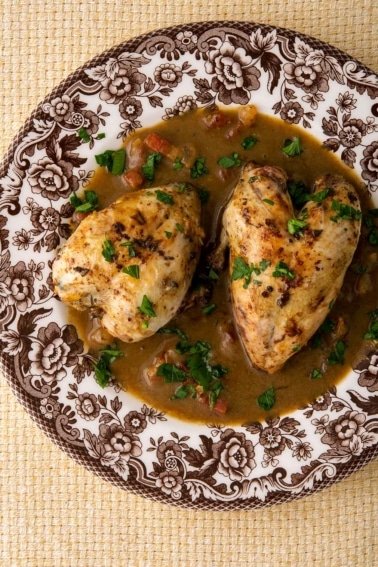
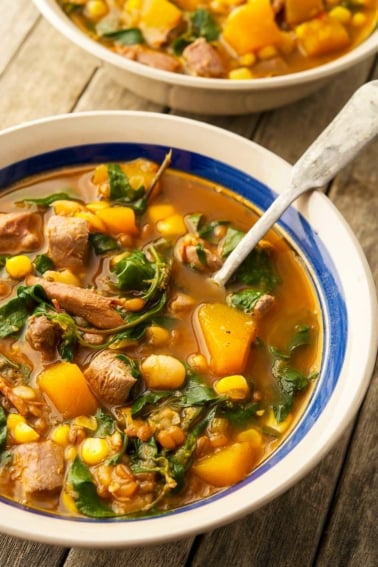
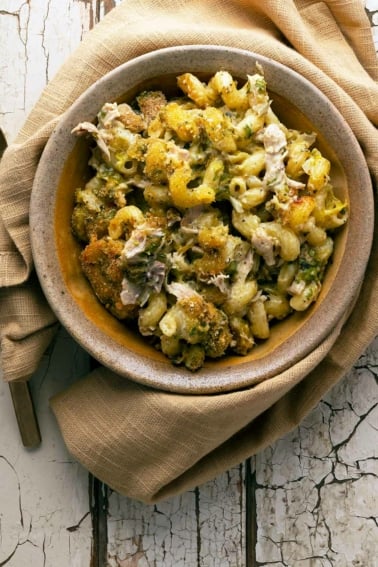
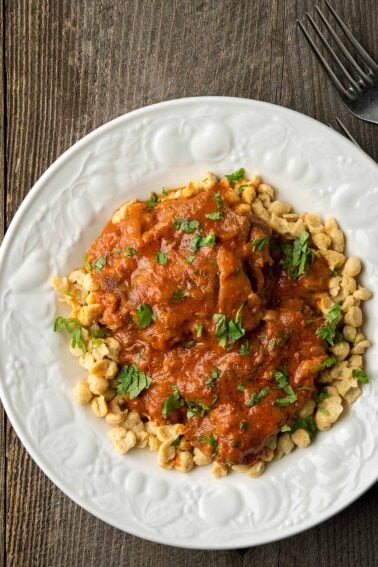
Hank,
Are the peanut oil amounts correct? Have they been flipped for frying and marinade?
I love this website and am looking forward to trying out more recipes!
John: The 3 cups is for frying. There is no oil in the marinade itself. Sorry, that’s a formatting issue.
This has become a monthly dish in our house, even when the pheasant runs out we switch to chicken….its that good! I like it a little sweeter so when the wife isn’t looking I add some additional sugar to the sauce.
Sounds awesome. I’ll have to remember this
Made this recipe tonight – used breast and thigh meat – it was incredible! I did coat the marinated pieces in cornstarch before frying, which made them very crispy. The sauce was as you said, too tomatoey when I tasted it cold, but perfect when cooked. I had brined the pheasant for 3 hours because I didn’t know what I was going to make, I think that only added to the tenderness of the pheasant. It was delicious. Thanks so much for being my “go-to wild game guy” – I got one of your cookbooks for a Christmas gift and am excited for that. Neither me or my husband are hunters, but we have generous hunter friends/family who love to share and we LOVE to eat it.
Do you think dove breasts would be another good substitution? General Tso’s is one of my favorites!
Thomas: Try it. It will be more beef-like though.
This was really good subbing in frog legs. Thanks for the recipe!
Dan: Sweet idea! Gotta try that.
I’m making this on Saturday with a combination of pheasant and cottontails, however, I’m going to have to leave out the eggs. My wife and kids are allergic.
Hank,
What kind of peppers do you use for this? I made it and it was very good but I am sure I didn’t have the right peppers.
Kevin: Chinese tsien tsin chiles. Dried chile de arbol would work, as would dried Thai chiles.
Dog found a couple of ditch chickens this morning. General Tso’s tonight, and will confit the legs on Friday. Your site and books are pure gold!
Thanks, Hank!
Have made this 2x and love it. Thanks for what you do. When I add the ginger it splatters horribly and clumps quickly. Any suggestions ? I’m using a wok over electric. To high heat? Ginger to wet?
Dennis: Huh. I think the ginger is too wet. But you should be stirring constantly.
Another winner! Made it with ruffed grouse and to my surprise, the flavor of the bird was very much still there. I was afraid the deep frying would make it taste like chicken. It was also very tender and moist which is not always easy with boneless grouse.
I had my doubts about the batter after I put the grouse in, thinking there would no be enough. Maybe my pieces were a little small and required more batter to be coated properly. I fried a test piece and it was not right. I decided coat the battered grouse with corn starch and fried a couple more pieces and it turn out perfect, very crisp.
I used much less hot pepper so it would suit my kids taste and everybody loved it.
I want to try this recipe, but there are more ways to fix pheasants than I have pheasants! Do you think this would be funky if I used some of my sharptails instead?
Roy: yeah, it would be a little weird. Sharpies are a dark meat, and this is a white meat dish. Better for chicken, pheasant, quail, ruffed grouse, turkey, etc.
After having an extremely successful cottontail hunt, I decided to try this recipe with your suggested substitute. Unfortunately I live in a culinary wasteland so I didn’t have the black vinegar and had to go with malt. Everyone agreed it was good but had a little bit extra vinegar taste. I’ll try this again with either less malt vinegar or order some actual black vinegar. It’s a great way to utilize the dozen rabbits still in the freezer.
I love your recipe, very similar to what I have done with duck and shrimp. I don’t use the tomato paste. My son is in the Marines and likes to cook so I am sending him your site. Thank you for sharing your creativity and wit.
Oh man, your narratives are always gold, but this one really hit home. There are 3.5 days left of pheasant season here in Utah, and this recipe is happenin baby!
Hank,
I read an interview with you in a free magazine at a restaurant in Santa Fe in January and have been visiting your site frequently/using your books since then. I made this recipe with leg and wing meat from a wild turkey last week and it was extremely tasty (I made a couple of ingredient substitutions due to living in small town Texas). It did an excellent job making meat that is often tough and gamely enjoyable and flavorful. Thank you for your recipes and your website. I have been hunting all of my short life and its really cool to have such a catalog of new dishes to try with the game I am lucky enough to procure, and to have new things to try when cooking everything else. Please keep up the great work!
Best regards,
Ed Standefer
I just made this recipe and it exceeded all expectations. My supermarket didn’t carry tien tsin chiles so I substituted four Fresno peppers instead. I used a small yellow onion and I also didn’t have any sesame oil on hand. Due to the difference in onions I cooked those first and then added the peppers, etc.
Per Felix, I used four tablespoons of sugar in the sauce and it worked out perfectly. The flavors came together quite well even with the substitutions and alterations. This recipe is great!
Made this recipe today, and it turned out to be just like chicken they make on the Chinese restaurant or a Lil bit better.. I actually added 4 tablespoons of sugar to the sauce and it gave it the perfect taste,because one tablespoon is to little for my taste.. other than that it was great with some rice.
Hank, I made this last night with some woodcock I had left over from last season. It was absolutely amazing! Thank you for doing what you do. I’ve shared your site with all my pals who hunt, forage, fish, or like to cook.
Brittany: LOL. It’s quite the opposite, actually. Fresh oil will never taste as good as previously used oil. It is standard practice in *every* restaurant in the world. I typically reuse my oil 3-5 times before it begins to smell rancid.
Two things to watch: First, if you’ve heated the oil too high, it can go rancid quickly. Your nose is your guide. Second, keep one container of oil for seafood and one for land things. Reusing oil you fried fish in is OK — if you use it again to fry fish.